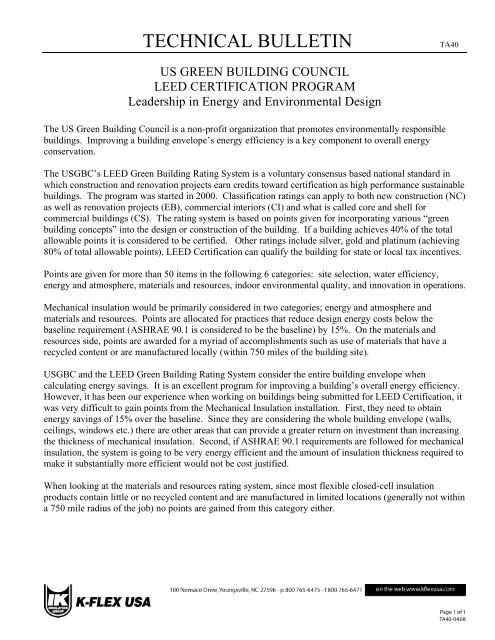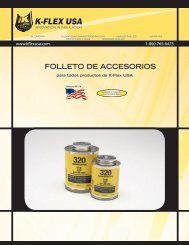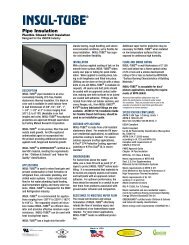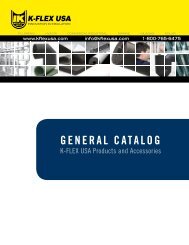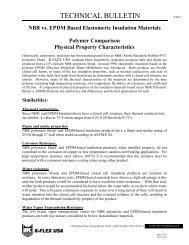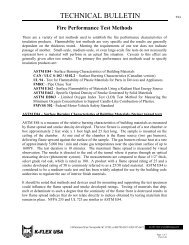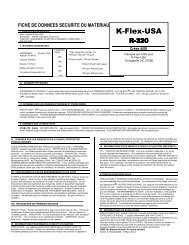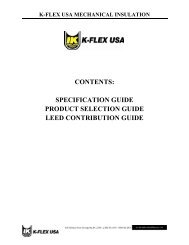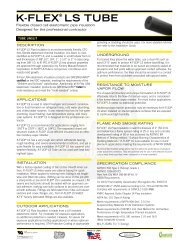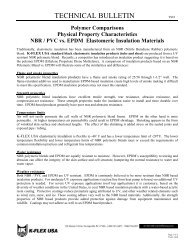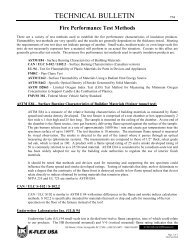TECHNICAL BULLETIN - K-Flex USA
TECHNICAL BULLETIN - K-Flex USA
TECHNICAL BULLETIN - K-Flex USA
You also want an ePaper? Increase the reach of your titles
YUMPU automatically turns print PDFs into web optimized ePapers that Google loves.
<strong>TECHNICAL</strong> <strong>BULLETIN</strong> TA40US GREEN BUILDING COUNCILLEED CERTIFICATION PROGRAMLeadership in Energy and Environmental DesignThe US Green Building Council is a non-profit organization that promotes environmentally responsiblebuildings. Improving a building envelope’s energy efficiency is a key component to overall energyconservation.The USGBC’s LEED Green Building Rating System is a voluntary consensus based national standard inwhich construction and renovation projects earn credits toward certification as high performance sustainablebuildings. The program was started in 2000. Classification ratings can apply to both new construction (NC)as well as renovation projects (EB), commercial interiors (CI) and what is called core and shell forcommercial buildings (CS). The rating system is based on points given for incorporating various “greenbuilding concepts” into the design or construction of the building. If a building achieves 40% of the totalallowable points it is considered to be certified. Other ratings include silver, gold and platinum (achieving80% of total allowable points). LEED Certification can qualify the building for state or local tax incentives.Points are given for more than 50 items in the following 6 categories: site selection, water efficiency,energy and atmosphere, materials and resources, indoor environmental quality, and innovation in operations.Mechanical insulation would be primarily considered in two categories; energy and atmosphere andmaterials and resources. Points are allocated for practices that reduce design energy costs below thebaseline requirement (ASHRAE 90.1 is considered to be the baseline) by 15%. On the materials andresources side, points are awarded for a myriad of accomplishments such as use of materials that have arecycled content or are manufactured locally (within 750 miles of the building site).USGBC and the LEED Green Building Rating System consider the entire building envelope whencalculating energy savings. It is an excellent program for improving a building’s overall energy efficiency.However, it has been our experience when working on buildings being submitted for LEED Certification, itwas very difficult to gain points from the Mechanical Insulation installation. First, they need to obtainenergy savings of 15% over the baseline. Since they are considering the whole building envelope (walls,ceilings, windows etc.) there are other areas that can provide a greater return on investment than increasingthe thickness of mechanical insulation. Second, if ASHRAE 90.1 requirements are followed for mechanicalinsulation, the system is going to be very energy efficient and the amount of insulation thickness required tomake it substantially more efficient would not be cost justified.When looking at the materials and resources rating system, since most flexible closed-cell insulationproducts contain little or no recycled content and are manufactured in limited locations (generally not withina 750 mile radius of the job) no points are gained from this category either.Page 1 of 1TA40-0408
<strong>TECHNICAL</strong> <strong>BULLETIN</strong> TA40Please note that many LEED Certification Projects have special requirements for adhesives. The projectspecification will typically require that adhesives comply with South Coast Air Quality ManagementDistrict (SCAQMD) Regulation 1168 for maximum allowable VOC content. K-<strong>Flex</strong> <strong>USA</strong> 720-LVOCAdhesive meets these requirements.We have filled out forms pertaining to our mechanical insulation materials for numerous LEEDCertification Projects. We are glad to complete the paperwork but to our knowledge, our materials have notprovided benefit in gaining LEED points.K-<strong>Flex</strong> <strong>USA</strong> is working in conjunction with NIA (National Insulation Association) to open discussions withthe US Green Building Council to revise the rating system but have not had success to date. If you haveany questions regarding the LEED rating system, please give us a call.Page 2 of 2TA40-0408


